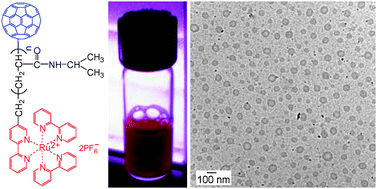Fullerene and ruthenium dual end-functionalized thermosensitive polymers: synthesis, characterization, electrochemical properties, and self-assembly†
Abstract
A general procedure for the synthesis of well-defined ![[double bond, length as m-dash]](https://www.rsc.org/images/entities/char_e001.gif) S–S–) of the RAFT-prepared PNIPAM
S–S–) of the RAFT-prepared PNIPAM

Maintenance work is planned from 09:00 BST to 12:00 BST on Saturday 28th September 2024.
During this time the performance of our website may be affected - searches may run slowly, some pages may be temporarily unavailable, and you may be unable to access content. If this happens, please try refreshing your web browser or try waiting two to three minutes before trying again.
We apologise for any inconvenience this might cause and thank you for your patience.
* Corresponding authors
a
Department of Chemistry, Clark Atlanta University, 223 James P. Brawley Drive SW, Atlanta, GA, USA
E-mail:
iharruna@cau.edu
Fax: +1-404-880-6890
Tel: +1-404-880-6883
b Coordinated Instrumentation Facility, Tulane University, New Orleans, LA, USA
c
Department of Materials Science and Engineering, Gwangju Institute of Science and Technology (GIST), 1 Oryong-dong, Buk-gu, Gwangju, South Korea
E-mail:
keg@ gist.ac.kr
Fax: +82-62-970-2338
Tel: +82-62-970-2316
A general procedure for the synthesis of well-defined ![[double bond, length as m-dash]](https://www.rsc.org/images/entities/char_e001.gif) S–S–) of the RAFT-prepared PNIPAM
S–S–) of the RAFT-prepared PNIPAM

 Please wait while we load your content...
Something went wrong. Try again?
Please wait while we load your content...
Something went wrong. Try again?
G. Zhou, J. He, I. I. Harruna and K. E. Geckeler, J. Mater. Chem., 2008, 18, 5492 DOI: 10.1039/B805449E
To request permission to reproduce material from this article, please go to the Copyright Clearance Center request page.
If you are an author contributing to an RSC publication, you do not need to request permission provided correct acknowledgement is given.
If you are the author of this article, you do not need to request permission to reproduce figures and diagrams provided correct acknowledgement is given. If you want to reproduce the whole article in a third-party publication (excluding your thesis/dissertation for which permission is not required) please go to the Copyright Clearance Center request page.
Read more about how to correctly acknowledge RSC content.
 Fetching data from CrossRef.
Fetching data from CrossRef.
This may take some time to load.
Loading related content
